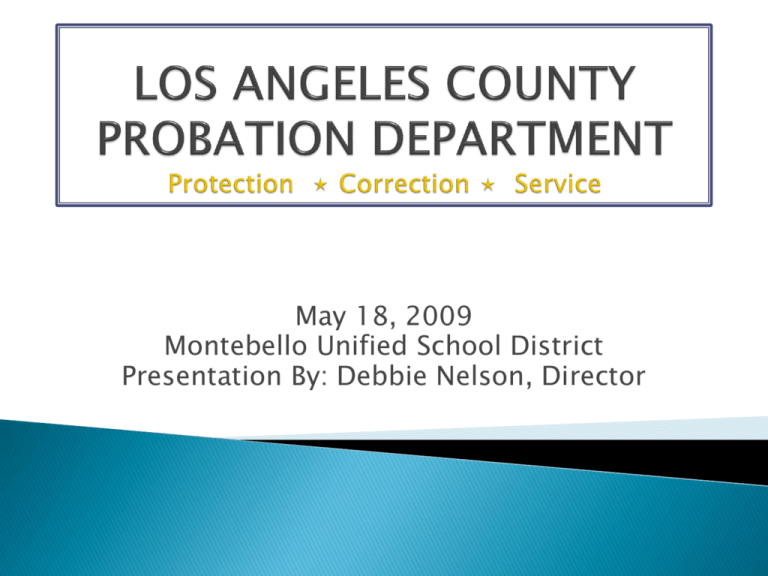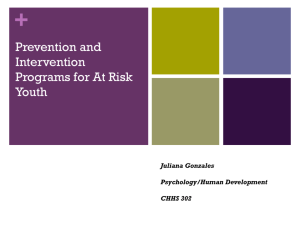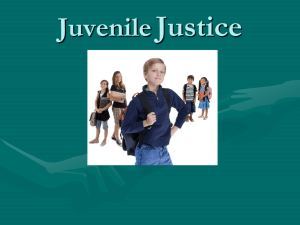LOS ANGELES COUNTY PROBATION DEPARTMENT Protection
advertisement

May 18, 2009 Montebello Unified School District Presentation By: Debbie Nelson, Director Established in 1903 Largest probation department in the world with 62,447 active adult probationers and approximately 20,000 active juvenile probationers. Over 6,000 employees with an operating budget of approximately $700 million. Over two-thirds of the employees are engaged in a professional aspect of probation work such as Deputy Probation Officers, Pretrial Release Investigators and Detention Services Officers. Consists of 9 Bureaus: Adult Field Services, Juvenile Field Services, Juvenile Special Services, Detention Services, Residential Treatment Services, Placement Services, Management Services, Quality Assurance Services, and Information Systems. Serves all municipal and superior courts of the County. Provides services to the community via sanctions to the court, enforcing court orders, operating correctional institutions, incarcerating delinquents, assisting victims and providing corrective assistance to individuals and families. Work locations include 3 juvenile detention centers, 19 residential treatment facilities/camps and 23 field service offices. MISSION: Promote and enhance public safety, ensure victims’ rights, and facilitate the positive behavior change of adult and juvenile probationers. Pretrial Services Division, Adult Investigations, Adult Supervision and Special Services functions. Services in 19 field offices and in more than 19 court locations. Pretrial Services consists of 7 programs: Bail Deviation, Own Recognizance, Early Disposition, Drug Treatment, Drug Court Electronic Monitoring and the Civil Court Name Change Petition Program. Pretrial Services completes over 88,000 eligibility assessments/reports a year. Adult Investigations conducts approximately 72,000 investigations per year. The Bureau produces 92,000 supervision reports per year. Juvenile population between 1,500 to 1,800 daily. Provides intake, housing and transportation services for minors detained in the 3 juvenile halls for pre-adjudicated and post-disposition wards of the juvenile court. Provides comprehensive medical, dental, mental health, educational, religious, recreational, counseling, mentoring, and tutoring services, on-site. Behavior Management Program Family Resource Center at each juvenile hall. Operation Read Literacy Program Camp Community Placement provides intensive intervention and programming based upon Evidenced Based Practices in a residential treatment setting. Average daily population approximately 1,500 Services Include: Teaching Pro-social Skills Getting Motivated to Change Girls Moving On Specialized Education Services and Tutoring Vocational Training and Structured work experience Athletic activities Juvenile Population of approximately 1,800 to 2,000 daily with 1,100 minors placed in group homes. Provides an environment for minors removed from their homes which best addresses their needs. Out-of-Home care can be in a Group Home, Psychiatric Hospital, with relatives and nonrelatives. Provides youth development, community transition, wraparound, and therapeutic services. Provide protection and safety to the community. Serve as an arm of the Superior Court. Provide investigation and supervision services on court ordered probationers. Recommend appropriate dispositions for juvenile offenders while preserving and enhancing the family unit. Provide probation services to non-probation at-risk youth. Juvenile Special Services Bureau consists of very specialized, high profile programs working with low to extremely high-risk probationers. Programs Include: Intake & Detention Control (IDC) Court Officer Intensive Gang Supervision Program (IGSP) Special Enforcement Operations (SEO) Camp Community Transition Program (CCTP) Community Detention Program (CDP) Division of Juvenile Justice Re-Entry Program (DJJ) LAPD Valley Operation Community Impact Team Retail Service Vocation Program (RSVP) Project Youth Embrace (Challenge Grant) Abolish Chronic Truancy (ACT) Watts Six Cities Anti-Gang Initiative Young Women At Risk (YWAR) Juvenile Justice Crime Prevention Act Programs (JJCPA) Originally the Schiff-Cardenas Crime Prevention Act of 2000 Renamed JJCPA in 2001 Authorized funding for county juvenile justice programs. Programs must be based on approaches demonstrated to be effective in reducing delinquency. Each county submits an annual report to CSA which compiles all the county reports into an annual report to the legislature. Measures include arrests, incarcerations, probation violations, and successful completion of probation, restitution, and community service ( the Big Six). Results on the “Big Six” are generally positive for completion of probation, payment of restitution, and completion of community service. Results on the “Big Six” are generally negative for probation violations (the more you look, the more you see). Arrests and incarcerations are mixed depending on the comparison groups and increasing arrests rates in the county may contaminate the comparisons. Designed to provide a full spectrum of communitybased services to probation and non-probation, atrisk youth. Probation Officers are placed in over 90 High Schools, 30 Middle Schools,7 Housing Developments and 4 Parks. Officers are liaisons between schools, housing, parks administration and the Juvenile Justice System. Supervise probationers and provide services to atrisk youth at assigned schools. Objective is to increase the opportunity for probation and at-risk youth to achieve academic success and to empower and support parents to become the primary change agent for their children. Collaborative Partners Include: L. A. City and County Parks and Recreation L.. A. City and County Housing Authority LAPD LASD Mental Health District Attorney LAUSD Superior Court Community-Based Agencies Services Include: 236 WIC Functional Family Therapy (FFT) Multisystemic Therapy (MST) Home-Based and Community-Based Gender Specific for both males and females Employment Readiness Operation Read – Literacy Program Gang Intervention Home-Based High Risk/High Needs Substance Abuse Counseling After-School Enrichment Understand that services and monitoring must be community-based provided in the youth’s/family’s own ecology. And, understand that education, youth involved in pro-social activities to develop pro-social skills, and strengthening the family are strong protective factors. ########





